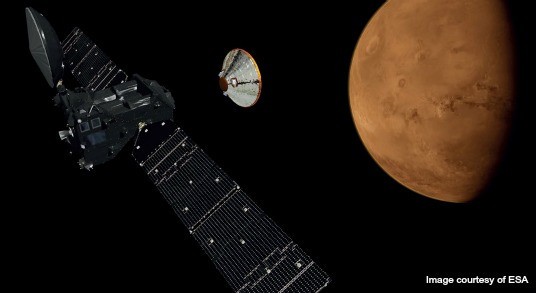Key GMV technology in ESA's mission to Mars

GMV has recently won three contracts within the flagship mission ExoMars, currently being carried out by the European Space Agency (ESA) in cooperation with the Russian Federal Space Agency (Roscosmos). The aim of the mission is to send two missions to the Red Planet, one in 2016 and another in 2018. These three contracts, all relating to the second ExoMars mission due for launch in 2018, are the following: firstly, development of the application software of the main onboard computer (Application SW); secondly, development of the software verification facility (SVF) and finally development of the onboard computer simulator (OBC1).
GMV has already been working for three years on the first ExoMars mission, scheduled for launch in March 2016. This mission comprises two spacecraft: the trace gas orbiter (TGO) satellite that will orbit Mars to analyze the gases of the Martian atmosphere; and the entry, descent and landing demonstrator module (EDM), which will separate off from the TGO once it has gone into Martian orbit. GMV’s input to this first mission is to develop the OBSW of the guidance, navigation and control system of the EDM capsule. Beginning in autumn 2016, the TGO will be orbiting the red planet for five years to check for atmospheric gases that could be a sign of possible biological or geological activity. Three days before reaching Mars, the EDM will separate from the TGO and cross the Martian atmosphere at an initial speed of 21,000 k.p.h. After an aerobraking maneuver and parachute descent the module will then use a liquid fuel propulsion system to land on the planet’s surface. This whole process will be controlled by GMV-developed software.
If successfully carried through, the 2016 mission will be a red-letter event as the first Mars touchdown by a European spacecraft. The second mission, to be launched in 2018, comprises a carrier module (CM) and a descent module (DM) with a Martian rover inside. GMV’s participation involves not only guidance, navigation and control of the descent module (as in 2016) but also other subsystems (thermal system, remote-command system, guidance and control of the carrier module as well as the descent module, power system), apart from the aforementioned SVF and onboard computer models, which will be used in testing.
The second mission will end with the launch of the ExoMars exploration vehicle, the first Martian Rover to be deployed on the planet’s surface by Europe.